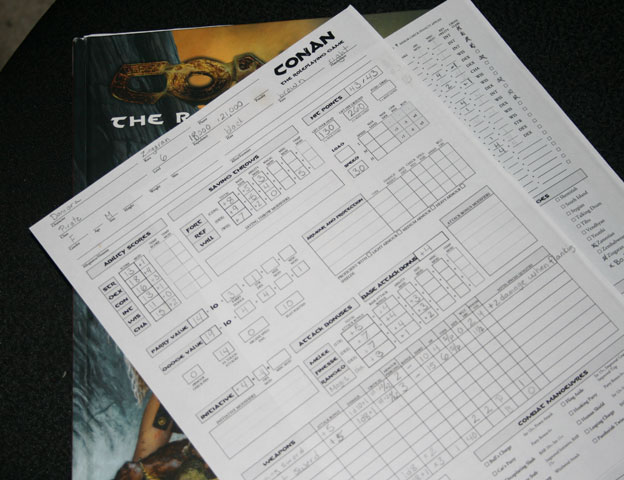CONAN: Equipment Deterioration
In your usual D&D game, a player has a keen interest in moving on to the next weapon. When he graduates from a longsword to a +1 long, he starts the search for a +2. When he finds the +2, he wants a +3. Once he gets the +3, he's looking for a +3 vorpal, and so on.
Not so in the Conan game as weapons like that don't exist. But, the Conan RPG does have all the important ingredients to make the upkeep of gear and the search for new stuff important to the player if the GM handles his game in a manner suitable to that goal.
I want my Cimmerians to respect steel. I want them constantly to live the life of a warrior, and part of that life is taking care of their gear. I've got a player who has a PC that is supposed to be a Cimmerian smith. Well, I want that character to be useful not just at the village in front of a forge but also while adventuring.
I also want my Cimmerians to spend their wealth on improving their gear. If they're not picking the dead on a battlefield, I want them trading with a smith in order to fix the nicks and dents in their favorite weapons and armor pieces. Occasionally, I'd like a shield to give out, a piece of armor become unusable, or have an enemy spy the horrible shape of the weapon used by his foe and attempt to use the Sunder rules to finish the weapon off, taking advantage of the weapon's sad shape.
I was looking through one of my favorite Third Party d20 supplements, From Stone To Steel (you can find it if you look), and I keyed in on the section that described adding Equipment Deterioration to a normal d20 game. The rules start on pg. 293 of that book, but I've got some thoughts for tweaking them for the Conan game.
These ideas are not playtested. I'm just brainstorming right now. If you've got a better idea, let's hear it.
In the next post, I'll get into the crunch.
In your usual D&D game, a player has a keen interest in moving on to the next weapon. When he graduates from a longsword to a +1 long, he starts the search for a +2. When he finds the +2, he wants a +3. Once he gets the +3, he's looking for a +3 vorpal, and so on.
Not so in the Conan game as weapons like that don't exist. But, the Conan RPG does have all the important ingredients to make the upkeep of gear and the search for new stuff important to the player if the GM handles his game in a manner suitable to that goal.
I want my Cimmerians to respect steel. I want them constantly to live the life of a warrior, and part of that life is taking care of their gear. I've got a player who has a PC that is supposed to be a Cimmerian smith. Well, I want that character to be useful not just at the village in front of a forge but also while adventuring.
I also want my Cimmerians to spend their wealth on improving their gear. If they're not picking the dead on a battlefield, I want them trading with a smith in order to fix the nicks and dents in their favorite weapons and armor pieces. Occasionally, I'd like a shield to give out, a piece of armor become unusable, or have an enemy spy the horrible shape of the weapon used by his foe and attempt to use the Sunder rules to finish the weapon off, taking advantage of the weapon's sad shape.
I was looking through one of my favorite Third Party d20 supplements, From Stone To Steel (you can find it if you look), and I keyed in on the section that described adding Equipment Deterioration to a normal d20 game. The rules start on pg. 293 of that book, but I've got some thoughts for tweaking them for the Conan game.
These ideas are not playtested. I'm just brainstorming right now. If you've got a better idea, let's hear it.
In the next post, I'll get into the crunch.

